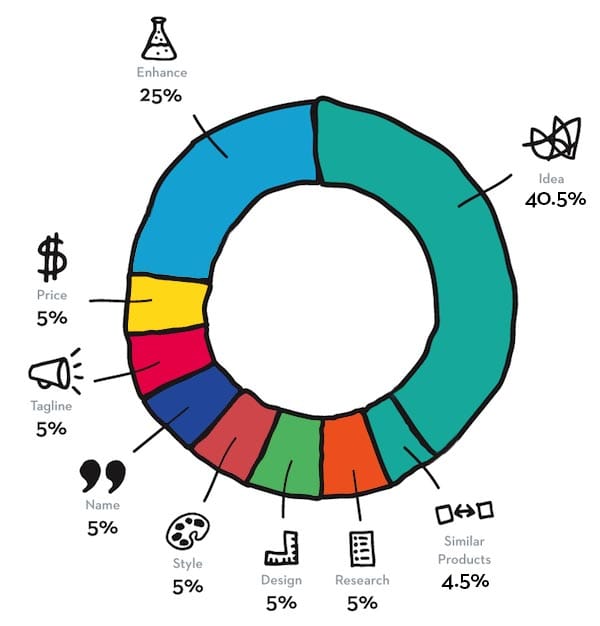Crowdsourcing Innovation: Quirky Will Pay for Your Opinion on New Inventions

From intellectual property to patent rules, the process of bringing an invention idea to market as a tangible item can be a long one. And although they’ve been airing on TV late at night for decades, we’re not sure we trust those infomercials that promise to make you a rich inventor.
Looking for an Internet-age alternative? Meet Quirky, which was founded to foster aspiring inventors. Since 2009, the crowdsourcing site has taken 400 products from idea to market — all thanks to ordinary people with extraordinary ideas.
But Quirky’s crowdsourced invention and product development platform isn’t just for wannabe inventors. If you have a knack for design or even naming, Quirky could be a way for you to earn a little extra cash.
How Quirky’s Users Helped Create Its Biggest Success Story
Consider Jake Zien, one of Quirky’s biggest success stories. As a design student, Zien had an idea for a power strip that would move around to accommodate uniquely shaped spaces and plugs. He pitched it to Quirky, and the resulting Pivot Power Surge Protector has been available in stores and online for about four years. Zien has made just over $600,000 in royalties.
However, Zien didn’t shape his product alone: 1,005 “influencers” helped bring Pivot Power to life, each sharing a piece of a pie worth more than $997,000. These influencers helped with tasks like naming the product, creating its tagline and helping set a price ($29). We’ll go into their roles a bit further in a moment.
While those influencers haven’t received checks for $992 each, they’ve received a small percentage based on their contributions to the development of Pivot Power. They’ve also watched their earnings add up over the years — just like Zien.
How Influencers Earn Money on Quirky
The math gets a bit complicated here, but stick with me. If a product submitted to Quirky is successfully developed and sold to the public, Quirky puts aside between 3 and 5% of gross revenue for the community who helped make it happen.
That influence pie pie of up to 5% is then broken down into specialized segments: product research, design, style, name, tagline and price each get 5% percent of that royalty pie. If you can provide comparisons between similar products during the development process, you can earn up to 4.5% of the royalty pie.
Here’s an example of how royalties are shared if you provide crucial design assistance for a product that makes it to market: “Out of the 5% influence reserved for this project,” Quirky explains, “3% will be yours for the taking if you submit an idea for a new feature or improvement that is used in the final product. There can be more than one chosen design idea, so it’s possible you may share that 3% with other designers.”
The biggest pieces? Suggesting product enhancements can earn you up to 25% influence. And, if your original invention or idea ends up going to market, 40.5% of the influence is all for you.

If you’re looking at these small percentages and wondering how much money your input will actually bring in, the New York Times has the simplest explanation:
“For its hard work, Quirky takes 90 cents of each dollar of product sales. The other 10 cents is distributed among the inventor community. The person who came up with the product idea typically pockets 4 cents of that. Lesser shares go for contributions like enhancing the idea, choosing the price or coming up with the name.”
Here’s the best way to think about it: If you’re interested in helping homegrown products come together for use by the masses, Quirky is a great hobby that can help you earn some spare change. But if you’re not going to submit original ideas, it’s not likely to be a significant source of income.
Influence: A Labor of Love
There are many, many participants on Quirky’s site who haven’t made any money — yet. Tracy McClarnon of Nebraska has gained some attention on Quirky for his idea of a task light that follows your movement as you work. Besides his own idea, he’s influenced 55 other inventions on the site. But none of those products has gone to market yet. McClarnon might earn some money, but he won’t be seeing those pennies for a while.
One reasonable tale of Quirky cash: Charles Bailey, a retired machinist and woodworker who influenced 52 projects during three active years on Quirky. He has earned just over $400 for his time, but had wisdom to share as he left the site a little over one year ago.
“Do not make Quirky your retirement plan,” he warned. “Submissions for product ideas should be treated the same way you deal with the lottery.” He advised participants to view Quirky as a hobby. “If it isn’t fun for you, move on.”
So if inventing or improving products is your idea of a fun night, you’ve found your community. You may not rake in the big bucks, but meaningful contributions can certainly add up over time.
Your Turn: Would you offer suggestions or improvements to products on Quirky in exchange for potentially earning money once they go to market?

















